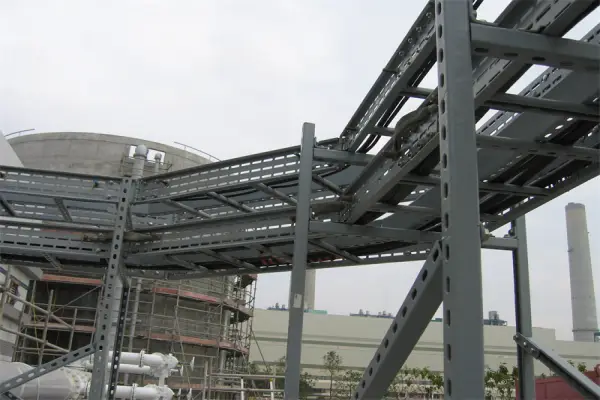What is steel channel?
Like other hollow sections, steel channel is rolled from steel sheet into C or U shapes. It consists of a wide "web" and two "flanges". The flanges could be parallel or tapered.
Steel channels are often found in bridges, wall studs, rafters, wooden beams, and beyond. They are known for their strength and durability in construction and other engineering applications. They help support heavy equipment or machines while allowing them to mute out loud sounds and decrease vibrations.
When it comes to structural steel components, U channels and C channels are two of the most commonly used profiles in construction, manufacturing, and engineering projects. While they may look similar at first glance, these two channel types have distinct characteristics, strengths, and applications. Understanding the differences between U channels and C channels is crucial for selecting the right material for your project. In this article, we’ll break down their key differences, applications, and how to choose the best option for your needs.
U-Steel Channels
U-steel channels sport a simple ‘U’ shape with two flanges that are parallel and perpendicular to the base. They are great materials for manufacturing since they are made to assist heavy machinery and equipment, especially in metal rolling. They are often used to support windows, doors, and flat panels.
Additionally, U-steel channels are found in hand railings for stairs or escalators. They can frame flat materials such as fabrics, glass panels, and wire mesh. Their versatility and strength make them essential components in various architectural and structural projects.
C Channel:
The C channel, also known as a "C-beam" or "C-section", has a shape that resembles the letter "C".It features a flat base with two flanges extending upwards, often with a slight inward curl at the edges.The flanges of a C channel are usually longer and may be tapered, providing more rigidity.
Key Differences Between U Channels and C Channels
|
Feature
|
U Channel
|
C Channel
|
|
Shape
|
U-shaped, symmetrical
|
C-shaped, asymmetrical
|
|
Flange Design
|
Parallel flanges
|
Perpendicular, tapered flanges
|
|
Load Capacity
|
Moderate
|
High
|
|
Applications
|
Light to medium-duty applications
|
Heavy-duty structural applications
|
|
Ease of Fabrication
|
Easier to cut and weld
|
Requires specialized tools
|
|
Cost
|
Generally lower
|
Slightly higher
|
The main difference between U-channel steel and C-channel steel is the cross-sectional shape. The shape of C-channel steel is C-shaped, while the shape of U-channel steel is U-shaped. This change in shape directly affects its load-bearing capacity and structural capacity.
From the application point of view, C-channel steel is often used for structural support of buildings, while U-channel steel is preferred for framing and fixing various components. In addition, the choice of C-channel steel and U-channel steel depends on the specific requirements of the project, including load-bearing capacity, structural design and installation preferences.

Differences in Application Areas between U Channels and C Channels
U Channel Applications
1.Framing and Edging: Used in door frames, window frames, and cabinet edging.
2.Support Structures: Ideal for lightweight shelving, racks, and brackets.
3.Automotive Industry: Commonly used in vehicle frames and body panels.
4.Electrical Conduits: Protects and routes electrical wiring.
C Channel Applications
1.Construction: Used in building frameworks, bridges, and support beams.
2.Industrial Machinery: Provides structural support for heavy equipment.
3.Transportation: Found in trailer frames, railings, and truck beds.
4.Architectural Design: Used for decorative and functional purposes in modern architecture.
How to Choose Between U Channels and C Channels
1. Consider the Load Requirements
U Channels: Best for light to medium loads, such as shelving or framing.
C Channels: Suitable for heavy-duty applications, like structural beams or machinery supports.
2. Evaluate the Environment
U Channels: Ideal for indoor or non-corrosive environments.
C Channels: Better for outdoor or harsh environments due to their higher strength and durability.
3. Check Fabrication Needs
U Channels: Easier to cut, weld, and customize for small projects.
C Channels: Require specialized tools and expertise for fabrication.
4. Budget Constraints
U Channels: More cost-effective for lightweight applications.
C Channels: Slightly more expensive but offer better value for heavy-duty projects.
Why Choose the Right Channel for Your Project?
Selecting the correct channel type ensures:
Structural Integrity: Prevents overloading and potential failures.
Cost Efficiency: Avoids overspending on unnecessary materials.
Longevity: Ensures the material can withstand environmental and operational stresses.
Conclusion
U channels and C channels serve distinct purposes in construction and manufacturing. While U channels are ideal for lightweight applications and ease of fabrication, C channels excel in heavy-duty structural projects. By understanding their differences, strengths, and applications, you can make an informed decision that aligns with your project’s requirements.
Need help choosing the right channel for your project? Contact us today for expert advice and high-quality U channels and C channels!
FAQs About U Channels and C Channels
Q1: Can U channels and C channels be used interchangeably?
Answer: No, their structural properties and load capacities differ. Always choose based on project requirements.
Q2: Which is stronger, U channel or C channel?
Answer: C channels are generally stronger due to their tapered flanges and higher load-bearing capacity.
Q3: Are U channels and C channels available in different materials?
Answer: Yes, both are available in steel, aluminum, stainless steel, and galvanized steel.
Q4: How do I determine the right size for my project?
Answer: Consult engineering specifications or work with a supplier to select the appropriate dimensions and thickness.






 English
English Español
Español بالعربية
بالعربية











 Phone :
Phone :  Whatsapp :
Whatsapp :  Email :
Email : 


